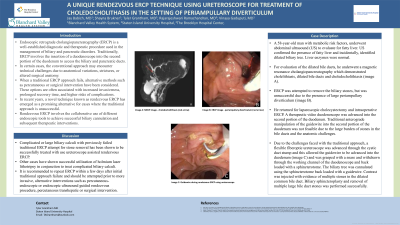Sunday Poster Session
Category: Biliary/Pancreas
P0080 - A Unique Rendezvous ERCP Technique Using Ureteroscope for Treatment of Choledocholithasis in the Setting of Periampullary Diverticulum
Sunday, October 22, 2023
3:30 PM - 7:00 PM PT
Location: Exhibit Hall

Has Audio
- TG
Tyler Grantham, MD
Staten Island University Hospital
Staten Island, NY
Presenting Author(s)
Jay Babich, MD1, Shayna Brukner, 2, Tyler Grantham, MD3, Rajarajeshwari Ramachandran, MD4, Vinaya Gaduputi, MD1
1Blanchard Valley Health System, Findlay, OH; 2The Frisch School, Paramus, NJ; 3Staten Island University Hospital, Staten Island, NY; 4Brooklyn Hospital Center, Brooklyn, NY
Introduction: Endoscopic retrograde cholangiopancreatography (ERCP) is a well-established diagnostic and therapeutic procedure used in the management of biliary and pancreatic disorders. We are reporting a case in which rendezvous ERCP was performed using a ureteroscope to aid in the removal of biliary stones.
Case Description/Methods: A 58-year-old man with metabolic risk factors, underwent abdominal ultrasound (US) to evaluate for fatty liver. US confirmed the presence of fatty liver and incidentally, identified dilated biliary tree. Liver enzymes were normal. For evaluation of the dilated bile ducts, he underwent a magnetic resonance cholangiopancreatography which demonstrated cholelithiasis, dilated bile ducts and choledocholithiasis (image A). ERCP was attempted to remove the biliary stones, but was unsuccessful due to the presence of large periampullary diverticulum (image B).
He returned for laparoscopic cholecystectomy and intraoperative ERCP. A therapeutic video duodenoscope was advanced into the second portion of the duodenum. Traditional anterograde manipulation of the guidewire into the second portion of the duodenum was not feasible due to the large burden of stones in the bile ducts and the anatomic challenges.
Due to the challenges faced with the traditional approach, a flexible fiberoptic ureteroscope was advanced through the cystic duct stump and this allowed the guidewire to be advanced into the duodenum (image C) and was grasped with a snare and withdrawn through the working channel of the duodenoscope and back loaded with a sphincterotome. The biliary tree was cannulated using the sphincterotome back loaded with a guidewire. Contrast was injected with evidence of multiple stones in the dilated common bile duct. Biliary sphincteroplasty and removal of multiple large bile duct stones was performed successfully.
Discussion: Rendezvous ERCP is a viable option for patients with altered anatomy or large biliary calculi who failed traditional ERCP. Repeat ERCP is a preferable option in these patients prior to consideration of surgical interventions. A few cases of laser lithotripsy using flexible ureteroscope are reported in the medical literature for management of complex biliary calculi not amenable to traditional ERCP. In our patient with periampullary diverticulum and the large stone burden, rendezvous ERCP using a ureteroscope was performed successfully following failed attempts at traditional ERCP.

Disclosures:
Jay Babich, MD1, Shayna Brukner, 2, Tyler Grantham, MD3, Rajarajeshwari Ramachandran, MD4, Vinaya Gaduputi, MD1. P0080 - A Unique Rendezvous ERCP Technique Using Ureteroscope for Treatment of Choledocholithasis in the Setting of Periampullary Diverticulum, ACG 2023 Annual Scientific Meeting Abstracts. Vancouver, BC, Canada: American College of Gastroenterology.
1Blanchard Valley Health System, Findlay, OH; 2The Frisch School, Paramus, NJ; 3Staten Island University Hospital, Staten Island, NY; 4Brooklyn Hospital Center, Brooklyn, NY
Introduction: Endoscopic retrograde cholangiopancreatography (ERCP) is a well-established diagnostic and therapeutic procedure used in the management of biliary and pancreatic disorders. We are reporting a case in which rendezvous ERCP was performed using a ureteroscope to aid in the removal of biliary stones.
Case Description/Methods: A 58-year-old man with metabolic risk factors, underwent abdominal ultrasound (US) to evaluate for fatty liver. US confirmed the presence of fatty liver and incidentally, identified dilated biliary tree. Liver enzymes were normal. For evaluation of the dilated bile ducts, he underwent a magnetic resonance cholangiopancreatography which demonstrated cholelithiasis, dilated bile ducts and choledocholithiasis (image A). ERCP was attempted to remove the biliary stones, but was unsuccessful due to the presence of large periampullary diverticulum (image B).
He returned for laparoscopic cholecystectomy and intraoperative ERCP. A therapeutic video duodenoscope was advanced into the second portion of the duodenum. Traditional anterograde manipulation of the guidewire into the second portion of the duodenum was not feasible due to the large burden of stones in the bile ducts and the anatomic challenges.
Due to the challenges faced with the traditional approach, a flexible fiberoptic ureteroscope was advanced through the cystic duct stump and this allowed the guidewire to be advanced into the duodenum (image C) and was grasped with a snare and withdrawn through the working channel of the duodenoscope and back loaded with a sphincterotome. The biliary tree was cannulated using the sphincterotome back loaded with a guidewire. Contrast was injected with evidence of multiple stones in the dilated common bile duct. Biliary sphincteroplasty and removal of multiple large bile duct stones was performed successfully.
Discussion: Rendezvous ERCP is a viable option for patients with altered anatomy or large biliary calculi who failed traditional ERCP. Repeat ERCP is a preferable option in these patients prior to consideration of surgical interventions. A few cases of laser lithotripsy using flexible ureteroscope are reported in the medical literature for management of complex biliary calculi not amenable to traditional ERCP. In our patient with periampullary diverticulum and the large stone burden, rendezvous ERCP using a ureteroscope was performed successfully following failed attempts at traditional ERCP.

Figure: Image A: MRCP image - choledocholithiasis (red arrow)
Image B: ERCP image - periampullary diverticulum (red arrow)
Image C: Guidewire during rendezvous ERCP using ureteroscope
Image B: ERCP image - periampullary diverticulum (red arrow)
Image C: Guidewire during rendezvous ERCP using ureteroscope
Disclosures:
Jay Babich indicated no relevant financial relationships.
Shayna Brukner indicated no relevant financial relationships.
Tyler Grantham indicated no relevant financial relationships.
Rajarajeshwari Ramachandran indicated no relevant financial relationships.
Vinaya Gaduputi indicated no relevant financial relationships.
Jay Babich, MD1, Shayna Brukner, 2, Tyler Grantham, MD3, Rajarajeshwari Ramachandran, MD4, Vinaya Gaduputi, MD1. P0080 - A Unique Rendezvous ERCP Technique Using Ureteroscope for Treatment of Choledocholithasis in the Setting of Periampullary Diverticulum, ACG 2023 Annual Scientific Meeting Abstracts. Vancouver, BC, Canada: American College of Gastroenterology.
